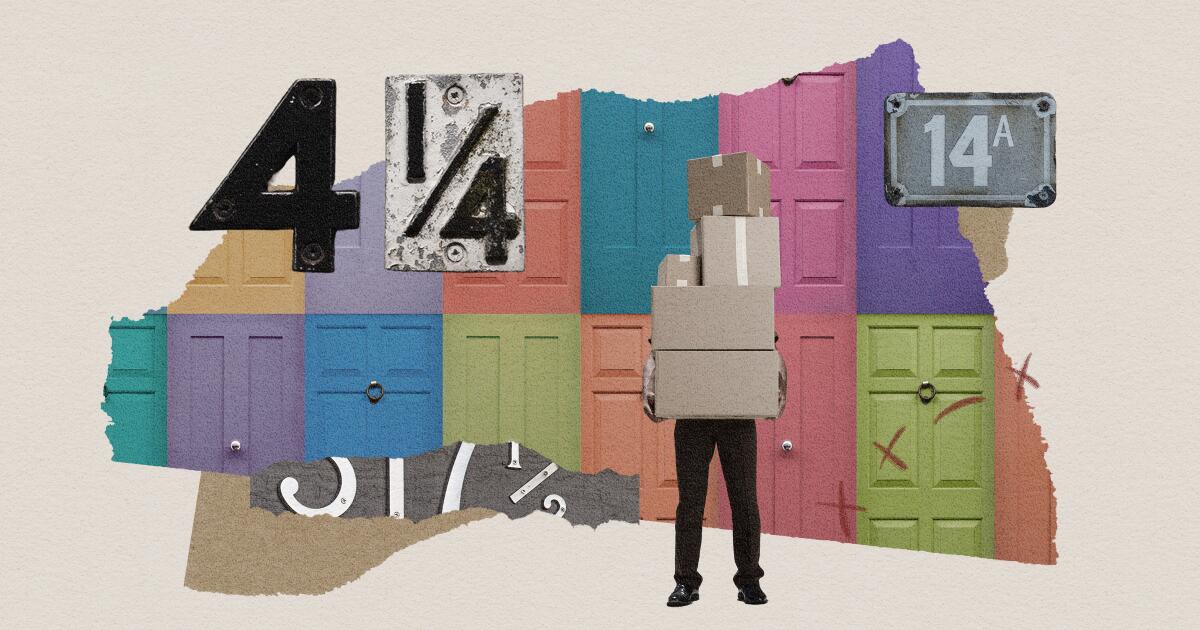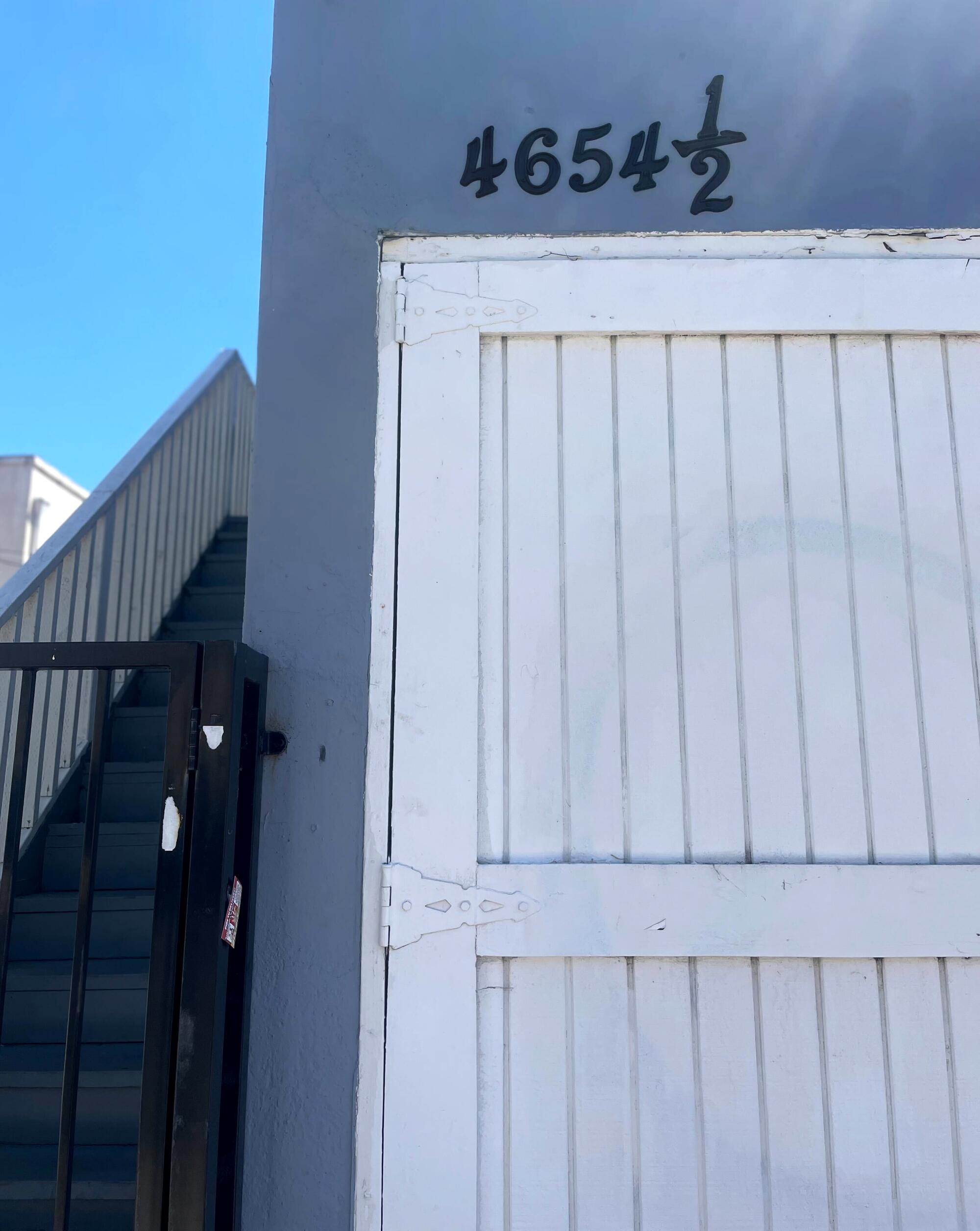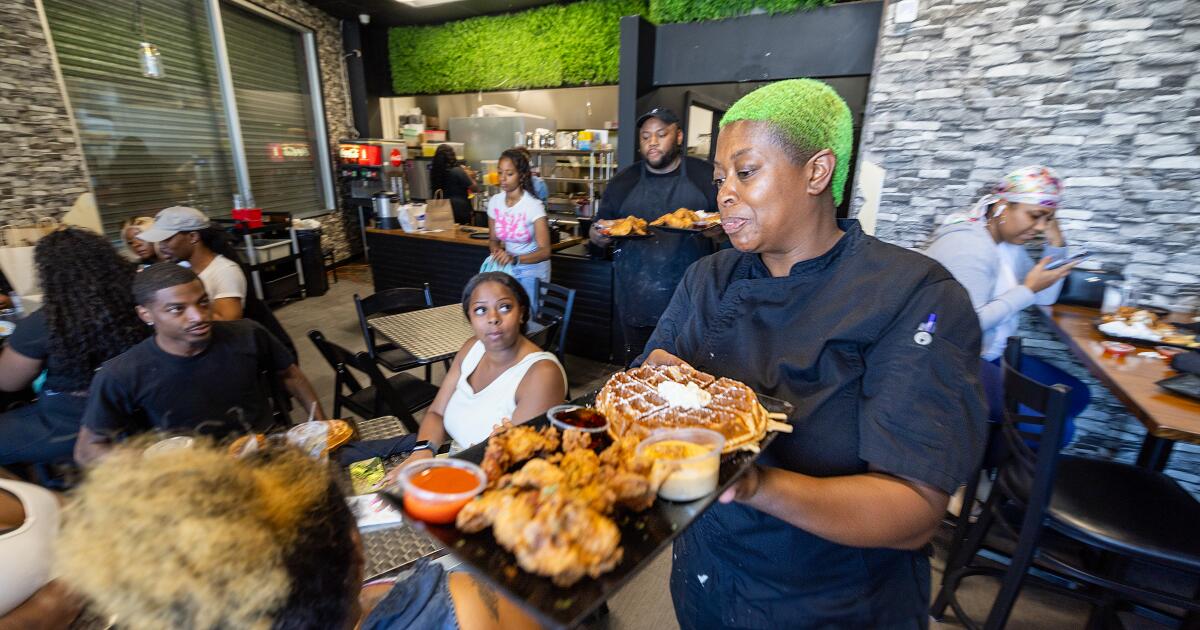Business
Your package wasn't delivered? Try living at one of L.A.'s '½' addresses

Casey Hogan had no idea her new address would be so frustrating.
But soon after moving into a granny flat in Van Nuys three years ago, she realized that the fraction in her house number — think: 101 ½ Main St. — was going to be particularly inconvenient in an era of constant deliveries.
Her packages get marked as “address not deliverable” or dropped off at the wrong door. Retail websites that are programmed to reject special characters, including the fraction’s slash, sometimes refuse her shipping address or auto-correct it to another location.
She has tried workarounds to this quirk of Los Angeles geography — most common in dense neighborhoods with duplexes or, as in Hogan’s case, at accessory dwilling units built on preexisting properties. Spelling out the fraction as “one half” has helped, but about a quarter of her packages or food deliveries arrive late or get dropped at someone else’s house.
In the case of a particularly urgent order before a flight, she had Amazon deliver a dog carrier to her mother’s home in Oceanside and drove there to pick it up instead of risking a snafu at her place.
“It’s still a nightmare,” said Hogan, 32, who works as a medical scribe. “Anything that could go wrong has gone wrong.”
In the increasingly deliverable world shaped by consumers’ skyrocketing, post-pandemic expectations that almost anything they want or need should arrive quickly and seamlessly at their doorstep, residents at more than 60,000 Los Angeles addresses like Hogan’s have been left on the sidelines. (Or really, left standing on their stoops, searching endlessly for packages.)
The shared inconvenience grew into a community on Reddit, where people swap tips, such as entering the address as a decimal — 101.5 Main Street — or spelling it out as Hogan does. One person made a more drastic suggestion: “Break down and get a P.O. box.”
Dealing with fractional addresses and other tricky deliveries, such as those behind gates, is equally frustrating — and costly — for retailers, logistics experts said, as well as for shipping companies that move more than 58 million packages a day in the United States.
The average American received about 70% more packages in 2022 than in 2017, according to a Capital One shopping research report. And a recent survey of 300 retail executives by the location data company Loqate found that almost 8% of first-time deliveries in the U.S. failed, costing about $17 per failed order — or roughly $200,000 a year.
Fractional addresses are sometimes written with slashes and other times with decimals — or, as at this home in East Hollywood, both.
(Marisa Gerber / Los Angeles Times)
“They have to deal with such a large amount of packages,” said Blake Droesch, a senior analyst at eMarketer who studies last-mile delivery. “This is not the post office of yore, where you could get an address half right, and the mailman will spend half the day trying to figure out who this letter belongs to.”
Since demand for deliveries spiked early in the pandemic, Droesch noted, there has been a significant shift in what people buy online, from items like new shoes or a laptop — things people didn’t mind waiting a few days to receive — to hygiene products and home essentials needed quickly.
“If you run out of deodorant,” he said, “you kind of need that the next day.”
Ram Bala, an associate professor of business analytics at Santa Clara University, studies the supply chain and is involved in a startup that will use generative artificial intelligence to improve shipping logistics.
Bala said it’s often odd little problems that sound simple to solve — in this case, figuring out how to accommodate fractional addresses — that end up being the trickiest.
“Anytime you try to fix that problem, there are unintended consequences somewhere else,” he said. “It’s a trade-off.”
Retailers don’t appear to be prioritizing a fix for people with fractional addresses, since doing so would require removing rigid formatting parameters built into software to ensure that normal addresses get entered correctly, Bala said.
In Los Angeles, which has about 1 million residential addresses, the roughly 60,700 fractionals are relative rarities. They’re concentrated in densely populated neighborhoods such as Boyle Heights, East Hollywood and Pico-Union, according to the city’s Bureau of Engineering, which oversees the handling of address numbers.
“The use of fractional numbers is discouraged and should only be used as a last resort,” a primer on the bureau’s website says.
A spokesperson for the city said the reticence to assign fractional addresses — which are often, but not always, ½ and never go beyond ¾ — stems from conversations with residents worried about not only confusing delivery drivers and visitors but the effect on property values. Still, it’s sometimes the best alternative when squeezing new units between existing ones.
The phenomenon isn’t unique to L.A.

Only about 60,700 of Los Angeles’ 1 million residential addresses have fractions.
(Marisa Gerber / Los Angeles Times)
Pockets of other big cities where large, historic buildings were divided into smaller dwellings, such as New York and Philadelphia, also have fractional addresses. And in an even more complicated twist detailed in a piece by Colorado Public Radio, the city of Grand Junction, Colo., has fractions in its street names, creating perplexing intersections such as C ½ and 28 ¾ roads.
Despite the delivery headaches, fractional addresses can carry a whimsical charm, often drawing comparisons to Platform 9 ¾, the fictional London train stop where students in the Harry Potter series caught the Hogwarts Express.
But for Juan Crespo, who started the Reddit thread asking for tips about living at a fractional address, it was more annoying than alluring.
Before moving into a unit in a Highland Park quadplex in 2021, the 32-year-old research scientist tried to change his shipping address with online retailers he used frequently, including Southwest Airlines and Target, where he and his spouse had created their wedding registry.
But the sites kept rejecting the slash.
He eventually called and, after a wait, got a Target employee to manually add the “½” to his address; by then, he said, several gifts, including a $300 stand mixer, had already been sent.
When ordering from DoorDash and Uber Eats, he said, his address would often be automatically switched to a different location a few blocks up, requiring him to enter a neighbor’s address instead.
“It was just a pain,” said Crespo, who has since relocated to Michigan and settled into a home with a full address number. “I’m glad we don’t have to deal with that anymore.”
For Hogan, who lives in the ADU in Van Nuys, the annoyance remains.
A few months ago, she posted to an online help forum, asking Google to have her fractional address added to Google Maps, since many retailers use the company’s mapping software to handle shipping logistics, and a problem there can create a ripple effect of issues on other sites.
“I have to resort to entering my neighbor’s address and hoping I can intercept the delivery person,” Hogan wrote. “HELP!”
A member of Google’s Product Experts Program, a group of volunteers who answer questions in exchange for perks from the company, quickly responded to Hogan saying that only an employee can add an address with a slash to the map. A volunteer asked her to upload a photo of her driver’s license or utility bill showing her address, but Hogan felt uncomfortable doing so and abandoned the effort.
She can easily rattle off a list of packages that never arrived or were initially dropped off somewhere else: workout clothes, two pairs of shoes from Nike, a showerhead from Jolie Skin Co. And she has gotten used to filing claims with shipping companies after getting notifications with pictures showing packages left in unfamiliar doorways. She bought a Ring doorbell camera and enabled the package notification feature, so she has proof that a delivery never arrived.
So many of her food deliveries got messed up, she said, that she set up a rack outside her gate with a sign that reads, “Leave food here.”
These days, she prefers to shop in person whenever possible and thinks twice before buying anything online — a hesitance, she admits with a laugh, that comes with a silver lining.
“I guess it does save me money.”

Business
In big win for business, Supreme Court dramatically limits rulemaking power of federal agencies

In a major victory for business, the Supreme Court on Friday gave judges more power to block new regulations if they are not explicitly authorized by federal law.
The court’s conservative majority overturned a 40-year-old rule that said judges should defer to agencies and their regulations if the law is not clear.
The vote was 6 to 3, with the liberal justices dissenting.
The decision signals a power shift in Washington away from agencies and in favor of the businesses and industries they regulate. It will give business lawyers a stronger hand in challenging new regulations.
At the same time, it deals a sharp setback to environmentalists, consumer advocates, unions and healthcare regulators. Along with the Biden administration, they argued that judges should defer to agency officials who are experts in their fields and have a duty to enforce the law.
This deference rule, known as the Chevron doctrine, had taken on extraordinary importance in recent decades because Congress has been divided and unable to pass new laws on pressing matters such as climate change, online commerce, hospitals and nursing care and workplace conditions.
Instead, new administrations, and in particular Democratic ones, sought to make change by adopting new regulations based on old laws. For example, the climate change regulations proposed by the Obama and Biden administrations were based on provisions of the Clean Air Act of 1970.
But that strategy depended on judges being willing to defer to the agencies and to reject challenges from businesses and others who maintained the regulations went beyond the law.
The court’s Republican appointees came to the case skeptical of the Chevron doctrine. They fretted about the “administrative state” and argued that unelected federal officials should not be afforded powers typically reserved for lawmakers.
“Chevron is overruled,” Chief Justice John G. Roberts Jr. wrote Friday for the majority. “Courts must exercise their independent judgment in deciding whether an agency has acted within its statutory authority.” Judges “may not defer to an agency interpretation of the law simply because a statute is ambiguous,” he added.
In dissent, Justice Elena Kagan said the Chevron rule was crucial “in supporting regulatory efforts of all kinds — to name a few, keeping air and water clean, food and drugs safe, and financial markets honest. And the rule is right,” she said. It now “falls victim to a bald assertion of judicial authority. The majority disdains restraint, and grasps for power.” Justices Sonia Sotomayor and Ketanji Brown Jackson agreed.
Senate Majority Leader Charles E. Schumer (D-N.Y.) voiced outrage. “In overruling Chevron, the Trump MAGA Supreme Court has once again sided with powerful special interests and giant corporations against the middle class and American families. Their headlong rush to overturn 40 years of precedent and impose their own radical views is appalling.”
Experts said the impact of the ruling may not be clear for some time.
Washington attorney Varu Chilakamarri said the ruling means “industry’s interpretation of the law will be viewed as just as valid as the agency’s. It will be some time before we see the effects of this decision on the lawmaking process, but going forward, agency action will be under even greater scrutiny and there will likely be more opportunities for the regulated community to challenge agency rules and adjudications.”
In decades past, the Chevron doctrine was supported by prominent conservatives, including the late Justice Antonin Scalia. In the 1980s, he believed it was better to entrust decisions about regulations to agency officials who worked for the president rather than to unelected judges. He was also reflecting an era when Republicans, from Richard Nixon and Gerald Ford to Ronald Reagan and George H.W. Bush, controlled the White House.
But since the 1990s, when Democrat Bill Clinton was president, conservatives have increasingly complained that judges were rubber-stamping new federal regulations.
Business lawyers went in search of an attractive case to challenge the Chevron doctrine, and they found it in the plight of four family-owned fishing boats in New Jersey.
Their case began with a 1976 law that seeks to conserve the stocks of fish. A regulation adopted by the National Marine Fishery Service in 2020 would have required some herring boats to not only carry a federal monitor on board, but also pay the salary of the monitor. Doing so was predicted to cost more than $700 a day, or about 20% of what the fishing boats earned on average.
The regulation had not taken effect, but it was upheld by a federal judge and the D.C. Circuit Court’s appellate judges who deferred to the agency’s interpretation of the law.
Business
State Farm seeks major rate hikes for California homeowners and renters

State Farm General is seeking to dramatically increase residential insurance rates for millions of Californians, a move that would deepen the state’s ongoing crisis over housing coverage.
In two filings with the state’s Department of Insurance on Thursday signaling financial trouble for the insurance giant, State Farm disclosed it is seeking a 30% rate increase for homeowners; a 36% increase for condo owners; and a 52% increase for renters.
“State Farm General’s latest rate filings raise serious questions about its financial condition,” Ricardo Lara, California’s insurance commissioner, said in a statement. “This has the potential to affect millions of California consumers and the integrity of our residential property insurance market.”
State Farm did not return requests for comment.
Lara noted that nothing immediately changes for policyholders as a result of the filings. His said his department would use all of its “investigatory tools to get to the bottom of State Farm’s financial situation,” including a rate hearing if necessary, before making a decision on whether to approve the requests.
That process could take months: The department is averaging 180 days for its reviews, and complex cases can take even longer, according to a department spokesperson.
The department has already approved recent State Farm requests for significant home insurance rate increases, including a 6.9% bump in January 2023 and a 20% hike that went into effect in March.
State Farm’s bid to sharply increase home insurance rates seeks to utilize a little-known and rarely used exception to the state’s usual insurance rate-making formula. Typically, such a move signals that an insurance provider is facing serious financial issues.
In one of the filings, State Farm General said the purpose of its request was to restore its financial condition. “If the variance is denied,” the insurer wrote, “further deterioration of surplus is anticipated.”
California is facing an insurance crisis as climate change and extreme weather contribute to catastrophic fires that have destroyed thousands of homes in recent years.
In March, State Farm announced that it wouldn’t renew 72,000 property owner policies statewide, joining Farmers, Allstate and other companies in either not writing or limiting new policies, or tightening underwriting standards.
The companies blamed wildfires, inflation that raised reconstruction costs, higher prices for reinsurance they buy to boost their balance sheets and protect themselves from catastrophes, as well as outdated state regulations — claims disputed by some consumer advocates.
As insurers have pulled back from the homeowners market, lawmakers in Sacramento are scrambling to make coverage available and affordable for residents living in high-risk areas.
Times staff writer Laurence Darmiento contributed to this report.
Business
High interest rates are hurting people. Here's why it's worse for Californians

By the numbers, the overall U.S. economy may look good, but down at the street level the view is a lot grimmer and grittier.
The surge in interest rates imposed by the Federal Reserve to slow inflation has closed like an acrid cloud over would-be homeowners, car buyers, growing families, and businesses new and old, large and small. It has meant missing opportunities, settling for less — and waiting and waiting and waiting.
It’s not that the average American is underwater. It’s that many feel that they’re struggling more than they anticipated and feel more constricted. In the American Dream, if you work hard, things are supposed to get better. Fairly or not, that may be a big part of why so many voters have expressed unhappiness with President Biden’s handling of the economy.
The cost of borrowing, whether for mortgages, credit cards or car loans, is the highest in more than two decades. And that is weighing especially hard on people in California, where housing, gas and many other things are more expensive than in most other states.
California’s economy also relies more on interest rate-sensitive sectors such as real estate and high tech, which helps explain why the state has been lagging in job growth and its unemployment rate is the highest in the nation.
Harder to budget
When interest rates rise, savers can earn more on their deposits. But in America’s consumer society, for most people higher rates mean that a lot of things cost a little (or a lot) more. That makes it harder to stretch an individual or family budget. It may mean giving up on the nicer car you had your heart set on, or settling for a smaller house, or a shorter, less glamorous vacation.
And with every uptick in interest rates, which is almost inevitably passed on to customers, some have had to give up on a purchase entirely.
Geovanny Panchame, a creative director at an advertising agency, knows these feelings all too well: He thinks often about what could have been if he and his wife had bought the starter home they were planning for in 2020.
Back then, they had been pre-approved at an interest rate of 3.1% — right around the national average — but were outbid several times. They figured they’d wait a few years to save more money for a nicer place.
Four years later, the couple are still renting an apartment in Culver City — and now they’re expecting their first child.
Pushing to buy a house and get settled before their son is born in December, they recently made an $885,000 offer for a three-bedroom, 1.5-bath home in Inglewood. They plan to put down 10%. At the current average mortgage interest rate of 7%, that would mean a monthly payment of about $5,300 — $1,900 more than if they had an interest rate of 3.1%.
The source of that increase is the Federal Reserve’s power to set basic interest rates, which determines the interest rates for almost everything else in the economy. The Fed’s benchmark rate went up rapidly, from near zero in early 2022 to a generational high of about 5.5%, where it has been for almost a year. The rate has been higher in the past, but after two decades in which it was mostly at rock bottom, most people had gotten used to both very low inflation and low interest rates.
“Clearly, we look back and we probably should have kept going and hopped into something,” Panchame, 39, said. “I’ve been really sacrificing a lot to get to this point to purchase a home and now I just feel like I got here but I didn’t work quick enough because interest rates have gotten the better of me.”
Add property taxes and home insurance, and it’s even more painful for home buyers because those costs have also risen sharply since the COVID-19 pandemic, along with housing prices themselves.
A typical buyer of a mid-tier home in California, priced at about $785,000 in the spring, was looking at a total housing payment of about $5,900 a month. That’s up from $3,250 in March of 2020 and almost $4,600 in March of 2022, when the Fed began raising interest rates, according to the California Legislative Analyst’s Office.
It wasn’t supposed to work like that: Lifting interest rates as fast and as high as the Fed did, in its effort to curb inflation, should have led to falling home prices.
But that didn’t happen, mainly because relatively few homes came on the market. Most existing homeowners had locked in lower mortgage rates before the surge; selling those houses once interest rates took off would have meant paying higher prices and interest rates on other homes, or bloated rents for apartments.
For most homeowners sitting on the low rates of the past, their financial well-being was further supported by low unemployment and incomes that generally remained on par with inflation or grew a little faster. And many had cushions of savings built up in early phases of the pandemic, thanks partly to government support.
All of which has kept the U.S. economy as a whole humming along, blunting the full effects of higher interest rates.
“Consumers are doing their job,” said Claire Li, senior analyst at Moody’s Investors Service, though she added that there are now signs of slower spending, evidenced by consumers cutting back on credit card purchases.
Unlike most home loans, credit card interest rates aren’t fixed. And today the average rate has bounced up to almost 22% from 14.6% in 2021, according to Fed data. That’s starting to squeeze more borrowers, adding to their unease.
Rising credit card debt
In California, the 30-day delinquency rate on credit cards is nearing 5% — something not seen since late 2009 around the end of the Great Recession, according to the California Policy Lab at UC Berkeley.
Lower-income and younger borrowers are more prone to falling behind on credit card, auto and other consumer loan payments than those with higher incomes. And it’s these groups that are feeling the effects of higher interest rates the most.
Christian Shorter, a self-employed tech serviceman who lives in Chino, just bought a used Volkswagen Jetta for $21,000. He put down $3,500 and financed the rest over 69 months at an annual interest rate of 24%. His monthly payment is more than $480, and by the end of the loan he will have paid about $15,000 in interest.
Shorter, 45, said he doesn’t have good credit. He plans to take out a personal loan when interest rates drop and pay off the car debt. “Definitely, definitely, they should lower interest rates,” he said of the Fed.
Between the jump in interest rates and prices of new vehicles, some auto buyers have downgraded to cheaper models. The biggest shift, though, especially in California, has been a move by more buyers to turn to electric vehicles to save on fuel costs, says Joseph Yoon, a consumer analyst at Edmunds, the car research and information firm in Santa Monica.
In May, he said, buyers on average financed about $41,000 on a new vehicle purchase at an interest rate of 7.3% (compared with 4.1% in December 2021). Over 69 months, that translates to a monthly payment of $745.
“For a big part of the population, they’re looking at this car market and saying, ‘I got to wait for something to break,’ like interest rates or dealer incentives,” Yoon said.
For a lot of small-business owners, who drive much of the economy in Los Angeles, they don’t have the luxury of waiting it out. They need funds to survive, or to expand when things are going well.
But many can’t qualify with traditional commercial lenders, and when they can they’re typically looking at interest rates of 9%; that’s more than double what they were before the Fed’s rate hikes, according to surveys by the National Federation of Independent Business.
One result: More and more people in Southern California are looking for help from lenders such as Brea-based Lendistry, one of the nation’s largest minority-led community development financial institutions.
From January to May, applications were up 21% and the dollar volume of loans rose 33% compared with a year earlier, said Everett Sands, Lendistry’s chief executive. Interest rates on his loans range from 7.5% to 14.5%.
“Business owners, they’re resilient, entrepreneurial, scrappy — they’ll figure out a way,” he said, adding that he sees many doing side jobs like driving for Uber or making Instacart deliveries at night.
Even so, Sands said, the higher borrowing costs inevitably mean less money spent on things like investing in new technology and software and bringing on additional staff, as well as delays in owners growing their businesses.
“Some of them lose out in progressing forward.”
‘When you put everything on the line, you get desperate.’
— Jurni Rayne, Gritz N Wafflez
Jurni Rayne, 42, started her brunch business, Gritz N Wafflez, as a ghost kitchen in February 2022, preparing food orders for delivery services. She financed that by maxing out her credit cards and getting a merchant cash advance, which is like a payday loan with super high interest rates. Her debts reached $70,000.
“When you put everything on the line, you get desperate,” said Rayne, a Dallas native who moved to Los Angeles a decade ago and has worked as a manager at California Pizza Kitchen and the Cheesecake Factory. “You don’t care about the interest rate, because it’s something like between passion and insanity.”
She has since paid off all the merchant loans. And her business has seen such strong growth that last year Rayne got out of the ghost kitchen and into a small spot in Pico-Union, starting with just three tables. She now has 17 tables and a staff of 14.
This fall she’ll be moving to a bigger location in Koreatown and has her sights on a second restaurant in South Los Angeles. But she frets that she could have expanded sooner if interest rates had been lower and she’d had more access to financing.
Economists call that an opportunity cost. For Rayne, it’s personal.
“Absolutely, lower interest rates would have helped me,” she said.
For many others, the wait for lower rates continues without the balm of intermediate success.
Lynn Miller, 60, began looking to buy a home in Orange County about a year ago, hoping to upgrade from her current 1,600-square-foot apartment.
“It’s not bad, it’s just not mine — the dishwasher is crappy, the washing machine is old,” she said of her rental in Corona del Mar. “I’m obviously not going to invest in these appliances. It’s just different not owning your own home.”
It’s been a discouraging process, she said, especially when she inputs her numbers into the mortgage calculators on Zillow and Realtor.com, which churn out estimates based on current interest rates.
“If you look at those monthly payment numbers, it’s shocking,” Miller, a marketing consultant, said. “It’ll get better, but it’s just not better right now.”
She’s continuing her house search — she’d love to buy a single-family, three-bedroom home with a backyard for a dog — but is holding off for now.
“I’m still waiting because I do think that interest rates are going to go down,” Miller said, although she knows it’s a guessing game. “I could end up waiting a long time.”
-

 News1 week ago
News1 week agoRead the Ruling by the Virginia Court of Appeals
-

 News1 week ago
News1 week agoTracking a Single Day at the National Domestic Violence Hotline
-

 Fitness1 week ago
Fitness1 week agoWhat's the Least Amount of Exercise I Can Get Away With?
-

 News1 week ago
News1 week agoSupreme Court upholds law barring domestic abusers from owning guns in major Second Amendment ruling | CNN Politics
-

 Politics1 week ago
Politics1 week agoTrump classified docs judge to weigh alleged 'unlawful' appointment of Special Counsel Jack Smith
-

 Politics1 week ago
Politics1 week agoSupreme Court upholds federal gun ban for those under domestic violence restraining orders
-

 Politics1 week ago
Politics1 week agoNewsom seeks to restrict students' cellphone use in schools: 'Harming the mental health of our youth'
-

 Politics1 week ago
Politics1 week agoTrump VP hopeful proves he can tap into billionaire GOP donors















